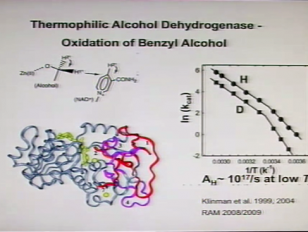From ‘On Water’ and Enzyme Catalysis to Single Molecules and Quantum Dots, Theory and Experiment

Presenter: Rudolph Marcus
Published: July 2014
Age: 18-22 and upwards
Views: 1696 views
Tags: chemistry;theory;calculate;compute;
Type: Lectures
Source/institution: Lindau-Nobel
Watch now
Much of theoretical chemistry has involved equations and their application to experiments, Debye, Debye-Hueckel, Transition State Theory, Kramers, LCAO, RRKM, among others. In fortunate circumstances one can, as in a theory of electron transfer reactions, relate different experiments to each other without adjustable parameters, and indeed make predictions without computations. More recently a major focus in theoretical chemistry has been on computations for individual systems, on the specific rather than on the generic, and not on equations relating data in different fields. In practice the two approaches are complementary. We choose for illustration two or three of the following topics where analytical theory, sometimes complemented by computation, is used to treat novel phenomena: catalysis of organic ‘on-water’ reactions in emulsions (1), enzyme catalysis, including several specific effects, the temperature independence of the H/D kinetic isotope effect for some enzymes operating under their natural conditions (2), an abnormal change in the Arrhenius pre-exponential factor for the catalytic rate of a thermophilic enzyme operating below its break-point temperature (2) (an analogy to a glass transition), predictions relating single molecule enzyme catalysis to other single molecule properties (3), and a topic drawn from the nanoparticle field, the intermittent fluorescence of semiconductor nanoparticles, interpreted in terms of an electron transfer, structural diffusion, and trap surface states theory (4). In particular what can be learned from single-molecule studies? Are they and the usual bulk ensemble studies complementary? The research topics were each stimulated by puzzles arising from the experiments.




